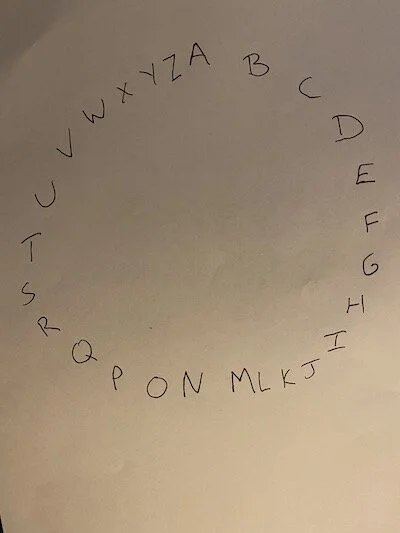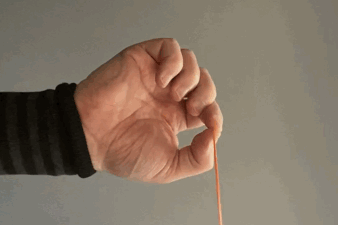Dustings #39
/Hey boys,
I’m taking next week off for a late spring break. Regular posting will resume on June 7th.
Jerx Hot Tip: If you’re looking for some more online magic content while I’m away, go to the site “google.com” and put the word “magic” in the search bar. You will get dozens of results.
From an email I received:
I found this lying on the sidewalk yesterday when I was out walking my dog. It's really weird, like some kind of experimental shield thing.
Actually, it's just a simple presentational construct for a Lubor's Lens but it fits me nicely. —DK
That’s great. The Reality Twister/Lubor’s Lens thing was pretty underappreciated in my opinion.
Here’s a Magic Cafe thread of a bunch of people not getting it.
“It’s just an optical illusion!” they say. Yeah, no shit. That was the point. The point was that you would use this weird lens thing to make objects distort or vanish when viewed through the lens. And just when people are thinking, “That’s an interesting optical illusion,” you do something with it that seems to actually affect some object in the real world.
The misunderstanding was that it was the optical illusion part by itself that was supposed to be amazing.
Another dumb thing people did with this was even done in the ad for the effect:
Your friend holds a pen on her open palm as you hold a clear "Credit Card Protector" just above the pen.
Why call it a “credit card protector”?
Because, Andy, magic with everyday objects is stronger.
Okay, sure. And how exactly is a clear “credit card protector” an everyday object?
Magicians get so caught up in the “everyday object” concern they think they can just make something an everyday object by claiming it is. That’s not how it works.
Not only that, but it’s a dead end presentationally.
“Behold the magic I create when you look through my credit card protector!”
The simple alternative is just to say. “Look at this thing I found. I have no idea what it is, but check out this strange thing it does.” That’s a perfectly fine default presentation: The object is a mystery and it does something impossible. Sometimes that’s all you need.
DK’s idea above of tossing it in an envelope and adding some obscure labeling to it in order to enhance that presentation is quite a good one.
Some say I’m responsible for both Penguin and Vanishing Inc having better shipping deals becausewithin weeks of me suggesting it in this post, Vanishing Inc came out with their VI+ program that offered free shipping with no minimums, and soon after that, Penguin started offering the same thing. Was it the Invisible Hand Of The Jerx that puppeteered these titans in the online magic industry? Perhaps.
So now I’m proposing another benefit one of the major magic companies should offer…
There’s nothing quite like buying an expensive book or trick and then three weeks later seeing it for 40% off. If there was a company that offered some sort of “purchase protection” where they would give you credit for the difference between what you paid and the sale price (within a certain amount of time, not eternally) they would have my business. And this would be something that is not just good for the customer. It would be good for the company that adopted this policy as well because it’s a policy that would be especially attractive to people making high-dollar purchases.
Through A Layman’s Eyes
I encourage my friends to not let me get away with stuff in a magic context. I want them to “go along” with the presentation, but I don’t want them to “go along” with the process of the trick if they think there’s something suspicious or questionable going on. I want to be able to sand off those suspicious or questionable moments, and I can’t necessarily spot them without their help. So I encourage people I know to call me out on stuff. This doesn’t always go so well when I introduce another person who does magic to my unforgiving friends.
A couple years ago one of my friends who does magic was performing for some of my non-magic friends. I forget what the exact trick was but it involved a Svengali-style pad that was made to look like a pad of Post-It notes.
When it was over, one of the people he was performing for said, “It’s a trick pad.”
Are my friends assholes? Well, no. I mean, some of them are, but that’s not what was happening here. They’ve seen me perform a bunch and I’ve asked them to be critical. I tell them it helps me. So that’s what they were used to.
When I asked my friend why he thought it was a trick pad, his girlfriend chimed in and said something like: “Because that’s not how you use Post-Its. That’s not the sort of pad you write on every page. He probably needs the pages to stick together for the trick or something, so he used post-its.”
Now, she was wrong about the method. But that’s not what matters. Their point still stands. You don’t use a Post-It pad to write on every page. You write on a page, pull it off and stick it on something or throw it out.
“That’s not true, Andy. I knew a guy, and every morning he would take his first bowel movement and microwave it and record how long it took to melt and he kept that information on a Post-It pad, and he never pulled the pages off and he kept all the pads like that until the day he set himself on fire.”
Okay, I get it. I’m not saying no human in history has ever used a post-it pad in that way. I’m saying it would be unusual. And in magic you want to limit the unusual things. Especially unnecessary unusual things.
It’s already somewhat unusual to ask someone to think of something from a pad (rather than from their head). Unless you can justify the pad, of course. And you would justify a pad by using it in a normal, human way. “I’ve been practicing my drawing and doing a daily sketch.” “I’ve been writing down a highlight of each day to try and be more present.” “I found this notebook my dad kept of the women he banged. It has their names, measurements, physical attributes, and rates them on scale of 1-10. Notice they’re all different. I want you to think of one of these women and I want to see if I can pick up on a psychic thought of my dad fucking them…. Okay… yes, I’m seeing a large breasted woman…red hair….” Etc. Etc.
It would be very difficult to make pulling out a pre-filled post-it pad feel natural. It would feel solely like a prop for a trick.
And there’s no reason to use the post-it version when they make perfectly good Svengali pads that are like the little spiral notebooks people do actually carry.
“But my pocket space!”
Ah yes, the true concern of the magical artiste. Okay, fine. If your primary concern is how much junk you can fit in your pocket, go with the post it notes.
Chris L. writes:
Just wanted to share this with you. Google has a morse code trainer that is spectacular.
https://morse.withgoogle.com/learn/
In literally ten minutes you can learn the full alphabet, just from using this website and installing the morse code keyboard on your phone. It might be a useful tool for people who fear that it might be too difficult to learn.
It’s a really good program. I didn’t bother downloading it on my phone, but I played around with the online version and it’s definitely one of the easier ways I’ve seen to learn Morse code. Thanks, Chris.
Okay, see you back here on June 7th.
Until then, I hope your next week is pure…





























